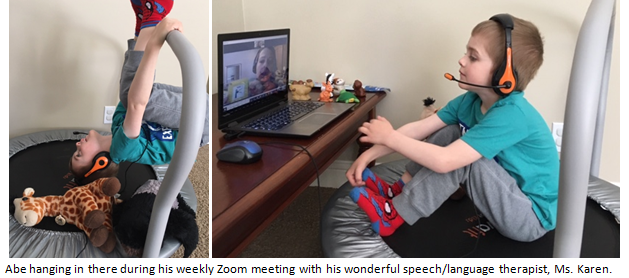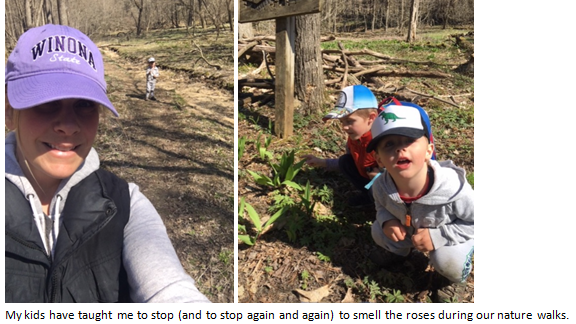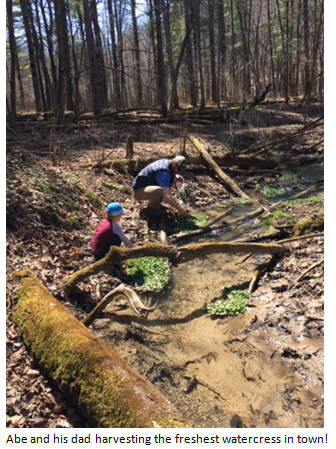Co-Teaching with Mother Nature
Categories“I hear a woodpecker.” “There’s another birch tree, Mommy.” “Look! I found a turkey feather, it’s soft.” These are a few examples of the many daily observations of my 5-year old son, Abe, that fill me with happiness and pride.
It’s been over two months since Abe’s beloved preschool physically closed and since then we've quickly become familiar with Zoom meetings three times per week. The teachers have been doing an amazing job of providing engaging online lessons (complete with different weekly themes) and supplemental learning materials for parents to implement between meetings. But it just doesn’t compare to the face-to-face instruction and peer interactions that the rich classroom environment provides.

Abe hanging in there during his weekly Zoom meeting with his wonderful speech/language therapist, Ms. Karen.
I have over 13 years of classroom teaching experience, but I am finding it to be more challenging to formally sit down and teach my own child than to teach other people’s children. During the first couple weeks of the school closures, I tried to force a “school” schedule on Abe (along with his 2-year old brother). Some days I felt like we were hitting all the learning standards, but most days my plans fell apart before 9:00 a.m. I soon tossed my broken color-coded schedule and the new flexibility allowed us to find our rhythm (while working around set online meetings and other obligations).
Now that spring is officially here, a significant part of my son’s learning has involved the great outdoors - Mother Nature has become my new favorite co-teacher. Although we continue to work on an appropriate utensil grasp with a traditional pencil and paper, getting Abe to practice his writing skills is a smoother and more enjoyable process when we’re outside using sidewalk chalk or simply drawing with a stick in the dirt. We blow bubbles and fly kites on breezy days to learn about the cardinal directions and wind speeds. Abe will shout, “The bubbles are going to the Wild West where the cowboys are!” or “The bubbles are moving fast to the North Pole.” We also play a version of “I spy” to practice rhyming. For example: I spy with my little eye something that rhymes with bee (tree).
We take lots of sensory nature walks and talk about what we see, hear, feel, smell, and taste along the way. We recently visited the Bjornson Education-Recreation Center in Menomonie, Wisconsin (near our home) where we explored the 400+ acre forest without any other humans in sight. We discovered animal tracks (deer and racoons) on the miles of nature trails, watched bumble bees pollinating wildflowers, identified birds and trees while discussing similarities and differences of the species, mindfully listened to the frogs, counted mushrooms, and noticed the variety of shapes, patterns, and colors that nature has to offer.

Not unlike most kids, my children love to play in water, so we spent a lot of time along the picturesque spring-fed stream that runs through the forest. We collected rocks, pinecones, acorns, sticks, leaves, and other treasures to experiment with the concept of sink versus float. We also harvested fresh watercress – Abe will not eat anything green in our kitchen, but he miraculously tasted the watercress right on the spot.

The curiosity, engagement, exploration, discovery, scientific thinking, problem-solving, sensory organization, motor development, and creativity that took place during our three hour visit to Bjornson far exceeded my learning expectations for Abe (no lesson plan nor schedule required). Overall, the adaptability, flexibility, and resiliency that both of my children (and so many other children worldwide) have demonstrated since the pandemic began has been impressive and inspiring. Our world has changed over the past several weeks, and so have my expectations of “normal”.
Here are a few classes related to this topic:
 FIND YOUR CENTER! Bundle - 5 Courses/15 Credits
FIND YOUR CENTER! Bundle - 5 Courses/15 Credits
 ADHD: Teaching and Learning Strategies
ADHD: Teaching and Learning Strategies
 21st-Century Learners: Reaching and Teaching the iGeneration
21st-Century Learners: Reaching and Teaching the iGeneration